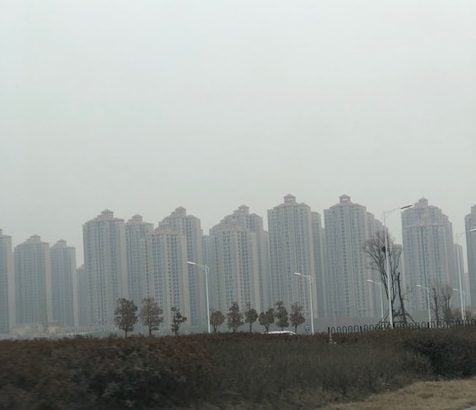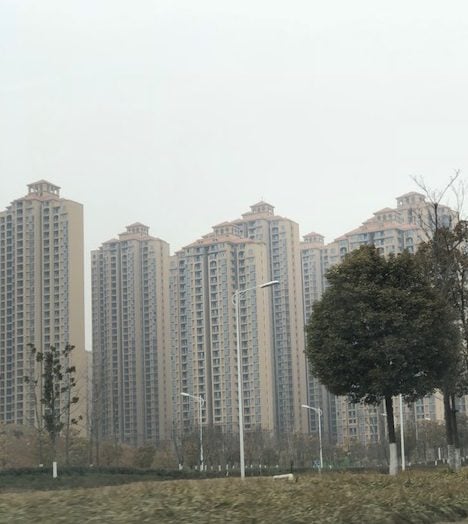Live from Hong Kong

China’s economy was slowing drastically last year before the coronavirus outbreak in Wuhan. There were multiple signs that China’s economy was in horrible shape. Today we provide a couple more examples.
In December 2019 we reported you can feel it in Hong Kong. The economy is sluggish. We reported for months that President Trump had the US in the position that it could only win in a trade deal with China and he did.
We reported in a post in August 2019 that President Trump recognized that China is in an all out war with the US in regards to information and economics. For years Western leaders have done nothing but negotiate into weak positions, never standing up to the Communist regime. Former US Presidents treated China like they did Russia 50 years ago, as their superior always giving them what they wanted and never standing up to their abuse and criminal acts.
We posted a presentation in August 2019 from former Trump Chief Strategist Steve Bannon regarding China. He discussed how China is in an economic war with the US. He said America was losing until President Trump. Then he added this:
Well here’s the game and right now we are converging on a point and they understand this. We could take the whole thing down. We can take, the whole thing’s built on a house of sand…
If they [China] devalue their currency they are just going to flood more out. They got $3 trillion of reserves and trust me, in a New York second that thing would flood out in a second. That’s what their own people think about their economy. We’ve allowed these guys to push us around. We’ve allowed these guys to take the South China Sea…
This trade war is going to end in victory and what you’re going to see is a reorientation of the entire supply chain out of China…
Today we provide a list of 11 Reasons China’s economy is on the brink of collapse. (This is an updated list from the 10 reasons we posted in February 2020.)
1. China over built real estate at levels worse than the US in 2008.
We reported in May 2019 that China’s current situation is very similar to the situation in the US that caused the ‘Great Recession’ memorialized in the movie ‘The Big Short’.
The cause of the 2008 sub-prime crisis is discussed in (my book) Falling Eagle, Rising Tigers:
Politicians would have you believe that the 2008 financial meltdown was related to the more recent actions of one party or the other, but the roots of the 2008 housing market crisis really began in the 1930s with the creation of the Federal Housing Administration (FHA), which guaranteed banks’ mortgage risks and the Federal National Mortgage Association (FNMA), which effectively insured mortgages by purchasing mortgages from lenders. Both shifted risks from the lenders to the US taxpayers. Then in 1977, the Community Reinvestment Act (CRA) was signed into law by President Jimmy Carter. This law was designed to promote home ownership for minorities by prohibiting banks from refusing mortgages in poor areas due to the loan’s high risk. In addition, mortgage lenders were required under the 1975 Home Mortgage Disclosure Act (HMDA) to provide data about who they lent to. Then in 1991, HMDA rules were tightened and included specific demands for racial equality in the institution’s lending.
Credit-worthiness was no longer relevant in the US and the volume of subprime loans exploded. The government had inserted itself in the mortgage business. Like most government initiatives, their plans were doomed. Americans lacking the ability to pay for mortgages were provided mortgages at teaser rates that when fully adjusted would never be paid. This ultimately climaxed in 2008 with the subprime crisis that sent shock waves around the world and put financial markets in a tailspin.
China’s actions somewhat mirrored those in the US in 2008. As China grew, it invested in its infrastructure and in addition, it invested in large housing projects throughout the country. These efforts helped bolster China’s already fast growing economy.
The problem is that China over invested in these random properties all over China and these properties today remain empty.
(See below pictures of real estate projects in the middle of China. Seen firsthand in Hubei Province, the epicenter of the Wuhan virus, these complexes are massive but mostly empty.)



There simply are not enough people in the area where these massive complexes were built that make enough money to afford living in these communities. It appears that the Chinese communists’ misunderstanding of supply and demand economics may ultimately be their downfall.
Some say, no problem, China will just move all the peasants to these massive complexes. This will be devastating. First of all China needs to feed them. Secondly, as we have learned in the US, people on the dole with no work tend to get involved in drugs and crime. The human spirit needs a purpose – idle hands are the devil’s workshop!
2. Related to real estate crisis is the fact cash-to-short-term debt levels are reaching all time lows for real estate companies.
These many properties throughout China sit unoccupied, and there is a cost to this. Bloomberg reported in September 2018 –
Cash-to-short-term debt levels at more than 80 publicly traded real estate companies tracked by Bloomberg were 133 percent on average in the first half, the worst since the first six months of 2015 and down from 297 percent a year earlier. Almost a quarter of developers sport a ratio below 50 percent.
3. China long term debt is also on the rise.
In addition, Bloomberg noted:
But while business has been booming, developers have also been piling on the debt. Firms have been selling more bonds in the domestic market — and at the cheapest rates as investors shrug off default concerns. Those with dollar-denominated obligations, meanwhile, face higher borrowing costs as the U.S. Federal Reserves continues on its tightening path.
4. The amount of debt in China is massive and the amount is unknown.
The total amount of China debt is unknown with S&P estimating the amount not reported by local communities and banks being over $6 trillion:
China may be sitting on a hidden debt pile of as much as 40 trillion yuan ($6 trillion), concealed off-balance-sheet by the country’s local governments, according to research from S&P Global Ratings.
Many local governments in China raise debt and hold it off their balance sheet, in order to avoid lending limits imposed by central authorities. S&P says that this is a growing problem within the country, and that the amount of debt held this way has likely ballooned in recent years.
(Note in the US it is considered fraudulent to maintain off-balance sheet accounts – accounts for liabilities not showing in an entity’s financial statements.)
5. China’s default risk is huge.
The government may have to take over these debts as they become insolvent –
Not only is the level of hidden debt held by local governments in the world’s second largest economy rising, but so too is the risk of those debts being defaulted on. Much of the debt is held by so-called local government financing vehicles (LGFVs), and S&P reports that central government may be willing to let these vehicles file for bankruptcy in the future.
“Default risk of LGFVs is on the rise. China has opened up the possibility of insolvent LGFVs filing for bankruptcy, but managing the default aftermath is a formidable task for top leadership,” the report noted….
The country’s total non-financial sector debt, which includes household, corporate and government debt, will surge to almost 300% of GDP by 2022, up from 242% in 2016. Fears abound that if this debt pile continues to grow, a spectacular blow up could be imminent.
6. Companies are leaving China in swarms.
I personally spoke with one China CEO last year who I know who said that a fellow manufacturing CEO in China said the economy in China was “terrible”. I also spoke with another head of a manufacturing company in China and he moved his operations to Thailand. He said that there was no more room in Vietnam for his company at a reasonable cost because Vietnam was full as companies from China, so he and his manufacturing plant moved to Thailand.
These are only two instances but are an indication of the economic crisis in China. The problem with this scenario is it provides China no ability to recover. It can only recover with business but the business is all leaving China. They can’t just continue to build and spend.
7. China incurred record corporate bond defaults in 2019.
Corporate bond debt defaults set a record in 2019:
The world’s second-biggest economy ended 2019 with record corporate bond defaults, a result of the slowest growth in nearly three decades. More than 150 onshore companies reneged on debt payments totaling about $19 billion. That was up from 120 companies and $17.6 billion in 2018.
8. China’s ratio of corporate debt to GDP jumped to 160% by the end of 2017.
China’s ratio of corporate debt to GDP is also large:
Fitch, S&P Global and other rating agencies are now warning of more to come as financing dries up for private companies, worsened by the global trade war and a decade of debt-fueled growth coming due. China’s ratio of corporate debt to gross domestic product jumped to a record 160% by the end of 2017 from 101% 10 years earlier.
9. China’s GDP growth rate before the coronavirus was likely negative.
The BBC reported on official China figures from last month. China’s GDP growth is the lowest its been in nearly 30 years and some economists believe it may actually be negative growth.
10. The Wuhan coronavirus is a killer. It’s killing China’s economy!
Hong Kong’s world class airport handled over 71 million passengers in 2019 which is around 200,000 passengers a day. According to the Hong Kong Immigration Department it’s now down to around 7,000 passengers a day. Hong Kong is not the only major airport in China seeing this pattern. The entire country is this way with almost no international flights going to and from China for the past month.
Unreal. We are the only people in the Cathay Pacific business lounge on a Sunday night. The largest airline in Hong Kong by far. The politicians are killing this city not the coronavirus. #COVIDIOTS pic.twitter.com/KtLtk3fp6L
— Joe Hoft (@joehoft) June 21, 2020
The streets and roads in some cities are closed down. The roads are empty. This all takes its toll on the economy.
11. There are some 400 China companies based on US stock exchanges and they all have suspected fraudulent financial statements.
Investor Carson Block was on Bloomberg in late May 2020 and he said the following about China companies:
I believe that a substantial number, more than, let’s call it a substantial majority are committing at least some level of fraud…. The reality is that in China a company that invents 30% of its revenue is considered real. I mean that’s you know if, because if you’re taking other peoples money in China, I mean, there’s an expectation that there is some level of graff and fraud. So 30% fake is real in China.
North of 50% is where they start to say, ‘Yeah, that’s a fraud’. 30 to 50% is kinda a grey zone. Faking profits without really faking a lot of revenue is the gold standard in China.
In China the people learned to lie under the Communist regime to stay alive. Their lives mean more than their integrity at this point in time. This is why the numbers coming out of China cannot be trusted. Whether they are related to business or the coronavirus, the numbers are fraudulent.
To think that only a couple of years ago under the Obama Administration the world was saying that China was soon to pass the US in GDP and reports were that this may have already occurred. Today the US is the world’s strongest and largest economy by far. It is now nearly twice as big as China’s and the US economy is growing while China’s economy is collapsing.
The post 11 Reasons Why China’s Economy is Failing and in Terrible Shape – NEVER Trust Data Coming Out of China! appeared first on The Gateway Pundit.
